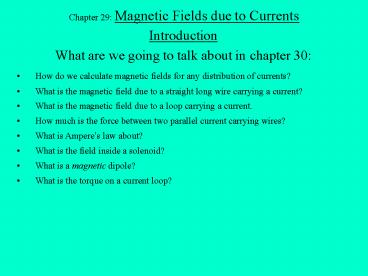Chapter 29: Magnetic Fields due to Currents - PowerPoint PPT Presentation
Title:
Chapter 29: Magnetic Fields due to Currents
Description:
Chapter 29: Magnetic Fields due to Currents Introduction What are we going to talk about in chapter 30: How do we calculate magnetic fields for any distribution of ... – PowerPoint PPT presentation
Number of Views:128
Avg rating:3.0/5.0
Title: Chapter 29: Magnetic Fields due to Currents
1
Chapter 29 Magnetic Fields due to Currents
Introduction What are we going to talk about in
chapter 30
- How do we calculate magnetic fields for any
distribution of currents? - What is the magnetic field due to a straight long
wire carrying a current? - What is the magnetic field due to a loop carrying
a current. - How much is the force between two parallel
current carrying wires? - What is Amperes law about?
- What is the field inside a solenoid?
- What is a magnetic dipole?
- What is the torque on a current loop?
2
29.2 Calculating the magnetic field due to a
current
Biot-Savart law dB (mo/4p) i dsxr/r2 mo 4p
10-7 T m/A
BSL is an inverse square law!!
If ds and r are parallel, the contribution is
zero!
3
Special cases For a straight wire making angles
q1 and q2 B (mo i/4pa)(cos q1- cos q2)
Prove it!
The direction is found through the right hand
rule
grasp the element in your right hand with your
extended thumb pointing in the direction of the
current. Your fingers will then naturally curl
around in the direction of the magnetic field
lines due to that element.
4
For infinite straight wire B (mo i/2pa)
At the center of a circular arc with angle f
B (mo i f/4pR)
The radial part extending from the arc does not
contribute why?
At the center of a circular loop B (mo i/2R)
Checkpoint 1
5
29.3 Force between two parallel currents
For two long, straight parallel wires a distance
d apart, the magnetic field created by current
ia at wire b is
Ba moia/(2pd) Therefore, the force felt at wire
b is
Fba Ib L x Ba L and B are perpendicular,
therefore Fba ib L Ba
Fba/L moiaib/(2pd)
6
What about the force which wire a feels?
The same!! Why? Fab/L moiaib/(2pd) In which
direction are the forces?
Towards one another if the currents are parallel
and away from one another if they are
anti-parallel.
In this way we can define the ampere!!
7
The rail gun
Is a device in which a magnetic force can
accelerate (106 g) a projectile to a high speed
(10 km/s) in a short time ( 1 ms).
Checkpoint 2
8
29-4 Amperes law
As we learned in section 30.1, if a current
carrying wire is grasped with the right-hand with
the thumb in the direction of the current, the
fingers curl in the direction of B.
Amperes law states that the closed path line
integral of B . ds around a circle concentric
with the current equals moienc.
9
Special cases The magnetic field outside a long
(thick/ circular) straight wire
B mo i/(2p r) for r gt R
The magnetic field inside a long (thick/
circular) straight wire with uniform current
density
B mo i r/(2p R2) for r lt R
10
What is the magnetic field created by an infinite
uniform current sheet Js, with a current i over a
perpendicular length of the sheet L such i
Js/L?
Interaction Prove it!
B mo Js/2
Checkpoint 3
11
29-5 Solenoids and Toroids
The field inside the solenoid is uniform. The
field between the turns tend to cancel. The field
outside the solenoid is weak!
The field of a solenoid is similar to that of a
bar magnet!
An ideal solenoid is one for which the turns are
closely spaced and the length is long compared to
the radius.
12
Applying Amperes law to an ideal solenoid gives
B mo (N/L) I mo n I inside B
0 outside
So, now we know how to create strong uniform
magnetic fields!!
Why do we use superconducting coils?
13
What is the magnetic field created by a toroid?
B mo N i/(2pr) inside B 0 outside
Note that B is not everywhere constant inside the
toroid!!
14
29-6 A current carrying coil as a magnetic
dipole
We have already seen that if a circuit of
magnetic dipole m is situated in a magnetic field
B, the circuit experiences a torque t produced
such that t m x B
Moreover, one can show that for points on the
central axis (take it to be the z-axis) of a
single circular loop, a circulating current i
produces a magnetic field
B(z) (mo/2) i R2/(R2z2)3/2
15
For points far from the loop (still on the
z-axiz), this can be cast in the form
B(z) (mo/2p) m/z3
Notice the similarity with the electric field and
the electric dipole!!
The circular loop current acts like a magnet
Checkpoint 4































